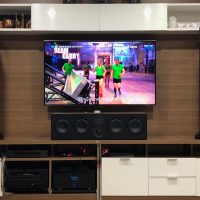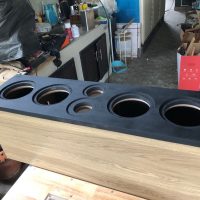
The Thor Main Towers and Center
PDF Files:
center_front_view_a tower_front_a crossover_1
Designer:
Corrie
Project Category:
Tower Speakers
Project Level:
Intermediate
Project Time:
20+ Hours
Project Cost:
Over $1,000
Project Description:
The Thor speakers comprise a pair of Large Tower and matching Centre speakers used for Movies and listening to music. The design comprises sealed enclosures for tight control of base response in a WWMTWW configuration. For the centre I decided on a WW(MT)WW design using 4 x 6.5” drivers due to the height restriction under my TV (and upgrading to a 65” unit later). The tweeter and midrange are arranged in a vertical configuration to avoid the typical issues of a D’Appolito design. The Thor Towers likewise feature a WWMTWW layout, with a vertical height restriction of 1200mm. For the towers I was forced to arrange the tweeter and midrange in a side-by-side configuration. I used 4 x 8” drivers for the towers – specifically to get maximum impact from high excursion drivers.
Design Goals:
Evaluating the market cost to replace my existing KEF Q series system, and my desire to design and build my own set of speakers, led me on this path. I needed an upgrade on my existing set of speakers, and desired bigger impact during movies. Having 4 x 8” drivers in the towers should provide a significant improvement in SPL, and using high quality drivers should provide the desired clarity and sound quality. The setup eventually is to become a full 11.4 design. I pondered the design for several months looking at a huge number of commercial and DIY designs on the web – pioneers like Troels Gravesen provided a lot of inspiration.
Driver Selection:
Center:
Woofer: TangBand W6-1721 – 4 x Part # 264-874
The W6-1721 6″ midbass features a long throw, underhung 1-1/2″ voice coil driven by a massive magnet. Weighing in at 5kg per driver, it amounts to 20kgs just for the drivers. The driver’s response allows a very simple crossover design.
Midrange: Morel EM1308 – Part # 287-030
The Elite EM 1308 is a 2-1/8″ dome midrange with very impressive specs. Many DIY designs use the better known MDM55, and this particular driver is better rated. I always wanted to use a dome midrange in my designs and this was an ideal selection – this dome is superb.
Tweeter: Morel ST1108 – Part # 277-096
The tweeter selection was the most difficult choice because I really wanted to use ribbons. I actually bought the ribbons and then decided to rather use silk domes. Morel tweeters consistently get good reviews, and these are no exception. I also experimented with the ET338’s, but the ST1108’s are definitely better. I have a superb combination between the EM1308 midrange and ST1108 tweeters. These drivers both include dispersion recesses machined into the faceplates, and this made the drivers rather immune to cabinet placement.
Towers (for each tower):
Woofer: TangBand W8-2096B – 4 x Part # 264-859
The W8-2096B 8″ woofer is specified as a low distortion and high excursion driver – these drivers feature massive motors and offer very robust and high quality construction. Weighing in at 7.6kg per driver, it amounts to 30kgs just for the drivers in each cabinet. This driver has a sealed F3 of 76Hz, but is still quite audible way down the frequency range. The driver is suitable for either sealed or ported applications.
Midrange: Morel EM1308 – Part # 287-030
Tweeter: Morel ST1108 – Part # 277-096
Enclosure Design:
I settled on sealed enclosures because in my opinion, they offer better and tighter control of the bass response. The cabinet sizes are as follows:
Center – 1000mm Wide, 270mm(H), and 350mm(D)
Towers: 1150mm(H), 288mm(W) and 375mm(D)
Although not required, I mounted the tweeters and midrange in their own enclosure. The enclosures were designed using BassBox pro – I am not impressed due to the limited software and old interface.
Enclosure Assembly:
The cabinets are constructed using 19mm MDF throughout, and a double front baffle with a 25mm wood outer front baffle on a 19mm MDF inner baffle. Simple butt joints have been used and supported by brad nails while drying. Significant horizontal and vertical bracing have been applied and the cabinets are acoustically dead. The drivers are all recessed into the front baffle. The heavy drivers are mounted using substantial wood screws through both layers of the baffle – I was tempted to use inserts for the W8-2096 drivers, but they have a wide mounting area and sufficient meat for the screws. All joints were caulk-sealed, and a thick layer of acoustic foam dampening glued to all inside surfaces of the panel. The enclosures are tightly filled with polyester material. The front baffle is rounded with a 12mm roundover bit and spray painted in matt black, applying several coats of paint and fine sanding in between layers provided a professional finish. Since I could not easily obtain wood veneer in Thailand, I decided on using Walnut laminate to finish the exteriors. These came out very nice, at the same time providing a very durable finish. The towers are mounted on special feet, and I will fit vibration dampeners at a later stage. The towers are very heavy, with 30.4kgs (67lbs) just for the drivers. I decided not to fit grills as I like the bare look of the panels. The center speaker is completed in the same way.
Crossover Design:
At first, I tried to use the Crossover Pro software, but then switched to Vituix CAD. The crossovers are still a work in progress and to make work easier, the crossovers are now mounted on the rear of each enclosure to facilitate easy changing of components and not having loose parts dangling by wires. In future I might convert to an active system. With the drivers I selected, I could have designed a 2 Way system using either 6.5” or 8” drivers combined with the ST1108 tweeter. Recommendations are to use a full three way for a good Centre speaker, which is why I am using a 3.5-way design – this is not a four-way design because both woofers play from low to their respective cut-off frequencies. I tried to keep the crossover designs simple and used second order filters where possible. With dome midrange drivers you must be more careful, and I used a 24dB/octave band pass filter. The drivers selected provide a large overlap across the crossover intersects and have very easy curves to work with. The 8” W8-2096 drivers are not flat up to 5kHZ as claimed and starts beaming pretty badly above 2.2kHz. The 6.5” W6-1721 however is quite usable up to 2.7kHz before it starts beaming. The Morel dome midrange is usable between 550 and 5500Hz. The ST1108 can be crossed as low as 1400Hz and operates up to 22kHz. I selected the frequency intersects as below based on common design criteria. I suppose these drivers would allow different crossover points that may sound equally good. I used the same voicing for the Towers and Centre. The F3 of the tower bass drivers were modelled at ~70Hz with these enclosures. In real life, with room gain, they are impressive.
The main crossover points and filter orders as follows:
Tweeter: 12 db/octave, crossover intersect at 4600Hz
Midrange voice filter: Bandpass filter at 24 dB/oct, 850Hz to 4600Hz
Inner Bass drivers: 12 dB/octave, crossing intersect at 850Hz to the midrange – these drivers play from low to 850Hz – this provides very good mid bass response with large driver surface area up to 850Hz
Outer Bass drivers: 12 dB/octave, crossing at 380Hz.
I used REW software and a Dayton OmniMic V2 to take system measurements to help optimize the crossover designs.
Tips & Tricks:
Don’t be scared of trying different combinations and designs – wood is cheap.
Properly setting up your saw is essential for achieving straight and parallel cuts – I use a contractor saw built-into a worktable and setting it up properly was very difficult and time-consuming. Even 0.5mm on a 1-meter cut may become an issue! Take care to properly adjust the saw blade to achieve straight and parallel cuts
Achieving a good result with recessed speakers can be difficult – you need a circle-cutting jig and patience. I cut all the same diameter holes at the same time to achieve the same diameter and cutting depth. Always measure twice and test-fit the drivers to make sure.
Applying the laminate can be tricky – especially when routing the edges. Make sure that the glue has dried before finishing the edges. Apply a layer of painter’s tape on the guiding edge to prevent the router from marring the laminate. When sanding, be careful not to round any of the edges to be laminated.
The drivers need a good amount of time for burning-in, and even capacitors take time to settle-in. Tuning DIY crossovers require patience and is time-consuming – you need to take time and keep records and notes of the various combinations.
Conclusion:
My setup is using an Onkyo PR-SC5530 surround processor, 5x700Watt RMS Class D DIY amplifier, 6x400W RMS Class D amplifier for the surrounds, custom made cables. The front end is provided by my Oppo UDP-203 Blue Ray player, and my Smart TV delivering music streaming via YouTube. I have three subwoofers in the rear – a massive 2.5kW 15” sub in the center, flanked by two 500WRMS 12” subs. Currently, the old KEF Q700’s are doing duty as the rear main surrounds in a 5.3 setup – I am rebuilding the 6x400W amp into a new enclosure.
I placed the two Thor Towers on either side of the TV, about 2m apart, angled inward at about 15 degrees. My main listening position is about 3m from the speakers. The center speaker is placed below the TV and slightly angled upwards. When listening to music, the subs are normally switched off, except when listening to live bands on YouTube.
I used several bass-boosted music tracks to test Thor’s capability in the deep bass region. I was surprised at how good these DIY sealed speakers sound in stereo mode with the subs disabled – it was almost as if there is a subwoofer in the system. This is due to the eight x 8” drivers providing real emphasis in the crucial bass and mid-bass region up to 850Hz – these speakers provide real bass “punch”. I love the way the drums sound – especially the drums, snare and kick!
I am a huge fan of Female voices and listened to several Diana Krall songs. The top end is smooth and makes for some easy listening. Listening to Madonna sing Like a Prayer, Express Yourself, and Till Death Do Us Part – her voice is sweet and clear. Listening to Ed Sheeran brings alive every raw emotion. Every speaker design sounds different with the same music, the Thor’s are very smooth in the highs and provides substantial bass punch – I love them! Both male and female voices are clear, articulate, and natural-sounding – making the singers sound as if they are present in the room.
Overall, I am very happy with the end-product. The appearance is professional, and they provide excellent sound re-production – I received good comments from everybody that ever listened to them. Listening to music is unreal – incredible sound stage and clarity. Human voices are especially well re-produced and sound life-like and in the room. With instruments you can hear every small detail, kickdrums are impressive. These speakers are very dynamic and provide high-definition sound reproduction. They have around 90dB/W efficiency, and with my system, they really come alive above the mid-volume setting. They play very loud and I cannot tolerate listening to reference levels. The center speaker is very impressive during movie scenes, and even the quieter scenes are crisp and clear. I am going ahead with the rest of the package to achieve my end goal of a full 11.4 system. This system is a massive step-up from my previous system and I am very happy with the result. A big build like this takes time and certain minimum skills to pull-off successfully. If you have woodworking skills and the necessary tools, this is a very satisfying hobby.
About the Designer:
I have an engineering background working in the Oil & Gas Industry (30 plus years). I have a passion for computers and electronics and build my own amplifiers – currently focusing on Class D. I have built several sub-woofers in the past, but this is my first large speaker project. I love to play with embedded controllers and have several Arduino/Raspberry PI projects around the house.
Project Parts List:
|
Part # |
Description |
Qty |
|
264-874 |
Tang Band W6-1721 6-1/2″ Underhung Midbass Driver |
4 |
|
287-030 |
Morel EM 1308 2-1/8″ Dome Midrange |
3 |
|
277-096 |
Morel ST 1108 Supreme 1-1/8″ Soft Dome Tweeter Pair – Black Faceplate |
3 |
|
264-859 |
Tang Band W8-2096B 8″ Underhung Midbass Driver 4 Ohm |
8 |






So you bought 50 of the Tang Band W8-2096B 8″ Underhung Midbass 4 Ohm Drivers just to build this project.? I guess I’m confused seeing the site says 50 is a minimum order? Wicked build though……….
Hi Jim O, I was fortunate to be able to buy my drivers before they implemented the totally silly minimum quantity – I need to buy more drivers for my surrounds (to complete the full 11.4 setup). I guess I will have to shop elsewhere now…this is really sad.